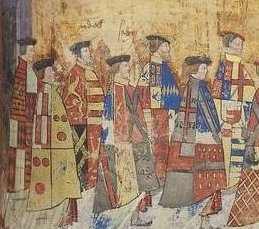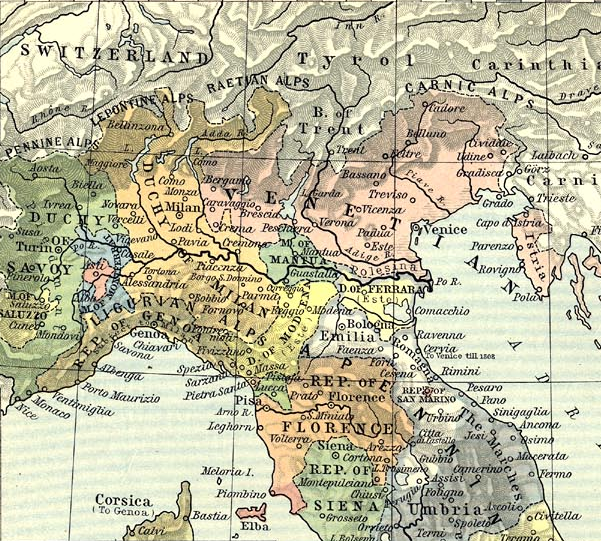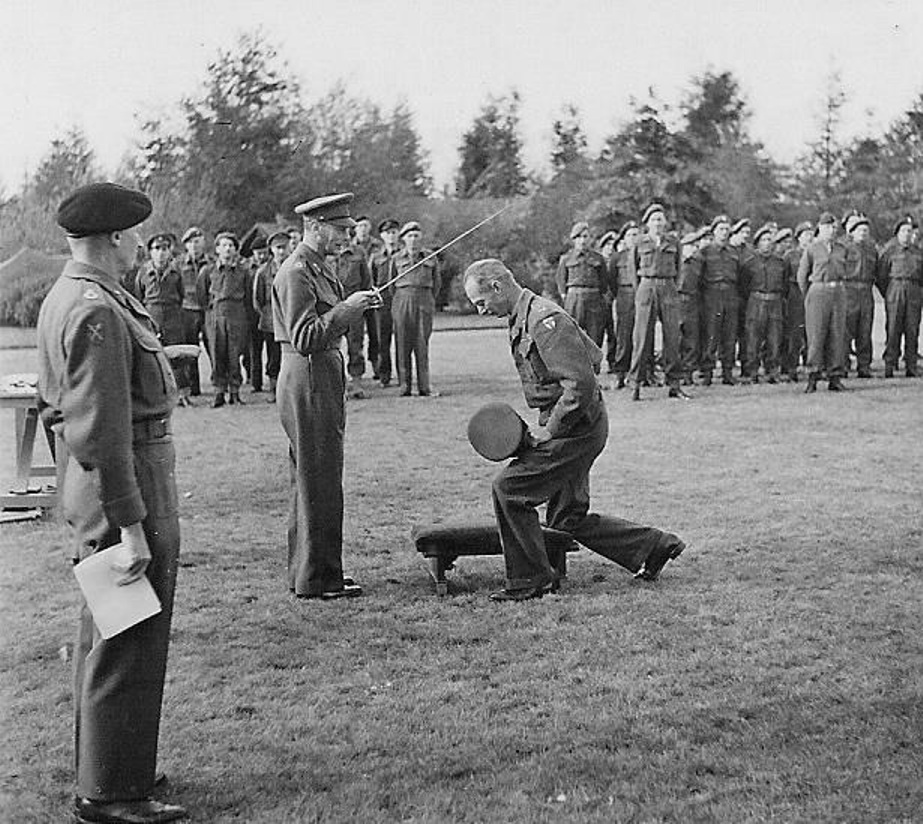|
Henry Courtenay, 1st Marquess Of Exeter
Henry Courtenay, 1st Marquess of Exeter, 2nd Earl of Devon (c. 1498 – 9 December 1538), KG, PC, feudal baron of Okehampton, feudal baron of Plympton, of Tiverton Castle, Okehampton Castle and Colcombe Castle all in Devon, was a grandson of King Edward IV, nephew of the queen consort, Elizabeth of York and a first cousin of King Henry VIII. Henry Courtenay was a close friend of Henry VIII, having "been brought up of a child with his grace in his chamber". Origins He was born in about 1498, the first and only surviving son and heir of William Courtenay, 1st Earl of Devon (1475–1511) by his wife Princess Catherine of York (died 1527), the sixth daughter of King Edward IV by his wife Elizabeth Woodville. His maternal first cousins therefore included King Henry VIII. Early life At the time of his birth in 1498, his paternal grandfather Edward Courtenay, 1st Earl of Devon (died 1509) was still living and Henry's father William Courtenay was his eldest son and heir ... [...More Info...] [...Related Items...] OR: [Wikipedia] [Google] [Baidu] |
Henry Courtenay - Order Of The Garter
Henry may refer to: People * Henry (given name) * Henry (surname) * Henry Lau, Canadian singer and musician who performs under the mononym Henry Royalty * Portuguese royalty ** King-Cardinal Henry, King of Portugal ** Henry, Count of Portugal, Henry of Burgundy, Count of Portugal (father of Portugal's first king) ** Prince Henry the Navigator, Infante of Portugal ** Infante Henrique, Duke of Coimbra (born 1949), the sixth in line to Portuguese throne * King of Germany **Henry the Fowler (876–936), first king of Germany * King of Scots (in name, at least) ** Henry Stuart, Lord Darnley (1545/6–1567), consort of Mary, queen of Scots ** Henry Benedict Stuart, the 'Cardinal Duke of York', brother of Bonnie Prince Charlie, who was hailed by Jacobites as Henry IX * Four kings of Castile: **Henry I of Castile **Henry II of Castile **Henry III of Castile **Henry IV of Castile * Five kings of France, spelt ''Henri'' in Modern French since the Renaissance to italianize the name and ... [...More Info...] [...Related Items...] OR: [Wikipedia] [Google] [Baidu] |
Henry VIII
Henry VIII (28 June 149128 January 1547) was King of England from 22 April 1509 until his death in 1547. Henry is best known for his six marriages, and for his efforts to have his first marriage (to Catherine of Aragon) annulled. His disagreement with Pope Clement VII about such an annulment led Henry to initiate the English Reformation, separating the Church of England from papal authority. He appointed himself Supreme Head of the Church of England and dissolved convents and monasteries, for which he was excommunicated by the pope. Henry is also known as "the father of the Royal Navy" as he invested heavily in the navy and increased its size from a few to more than 50 ships, and established the Navy Board. Domestically, Henry is known for his radical changes to the English Constitution, ushering in the theory of the divine right of kings in opposition to papal supremacy. He also greatly expanded royal power during his reign. He frequently used charges of treason and ... [...More Info...] [...Related Items...] OR: [Wikipedia] [Google] [Baidu] |
Man-of-war
The man-of-war (also man-o'-war, or simply man) was a Royal Navy expression for a powerful warship or frigate from the 16th to the 19th century. Although the term never acquired a specific meaning, it was usually reserved for a ship armed with cannon and propelled primarily by sails, as opposed to a galley which is propelled primarily by oars. Description The man-of-war was developed in Portugal in the early 15th century from earlier roundships with the addition of a second mast to form the carrack. The 16th century saw the carrack evolve into the galleon and then the ship of the line. The evolution of the term has been given thus: The man-of-war design developed by Sir John Hawkins had three masts, each with three to four sails. The ship could be up to 60 metres long and could have up to 124 guns: four at the bow, eight at the stern, and 56 in each broadside. All these cannons required three gun decks to hold them, one more than any earlier ship. It had a maximum sai ... [...More Info...] [...Related Items...] OR: [Wikipedia] [Google] [Baidu] |
Louis XII Of France
Louis XII (27 June 14621 January 1515), was List of French monarchs, King of France from 1498 to 1515 and King of Naples from 1501 to 1504. The son of Charles, Duke of Orléans, and Maria of Cleves, he succeeded his 2nd cousin once removed and brother in law at the time, Charles VIII of France, Charles VIII, who died without direct heirs in 1498. Before his accession to the throne of France, he was known as Louis of Orléans and was compelled to be married to his disabled and supposedly Sterility (physiology), sterile cousin Joan of France, Duchess of Berry, Joan by his second cousin, King Louis XI of France, Louis XI. By doing so, Louis XI hoped to extinguish the Orléans cadet branch of the House of Valois. Louis of Orléans was one of the great feudal lords who opposed the French monarchy in the conflict known as the Mad War. At the royal victory in the Battle of Saint-Aubin-du-Cormier (1488), Battle of Saint-Aubin-du-Cormier in 1488, Louis was captured, but Charles VIII pard ... [...More Info...] [...Related Items...] OR: [Wikipedia] [Google] [Baidu] |
War Of The League Of Cambrai
The War of the League of Cambrai, sometimes known as the War of the Holy League and several other names, was fought from February 1508 to December 1516 as part of the Italian Wars of 1494–1559. The main participants of the war, who fought for its entire duration, were France, the Papal States, and the Republic of Venice; they were joined at various times by nearly every significant power in Western Europe, including Spain, the Holy Roman Empire, England, the Duchy of Milan, the Republic of Florence, the Duchy of Ferrara, and the Swiss. The war started with the '' Italienzug'' of Maximilian I, King of the Romans, crossing into Venetian territory in February 1508 with his army on the way to be crowned Holy Roman Emperor by the Pope in Rome. Meanwhile, Pope Julius II, intending to curb Venetian influence in northern Italy, brought together the League of Cambrai — an anti-Venetian alliance consisting of him, Maximilian I, Louis XII of France, and Ferdinand II of Arag ... [...More Info...] [...Related Items...] OR: [Wikipedia] [Google] [Baidu] |
The Complete Peerage
''The Complete Peerage'' (full title: ''The Complete Peerage of England, Scotland Scotland (, ) is a country that is part of the United Kingdom. Covering the northern third of the island of Great Britain, mainland Scotland has a border with England to the southeast and is otherwise surrounded by the Atlantic Ocean to th ..., Peerage of Ireland, Ireland, Peerage of Great Britain, Great Britain, and the Peerage of the United Kingdom, United Kingdom Extant, Extinct, or Dormant''; first edition by George Cokayne, George Edward Cokayne, Clarenceux King of Arms; 2nd edition revised by the Hon. Vicary Gibbs ''et al.'') is a comprehensive and magisterial work on the peerage, titled aristocracy of the British Isles. History ''The Complete Peerage'' was first published in eight volumes between 1887 and 1898 by George Edward Cokayne (G. E. C.). This version was effectively replaced by a new and enlarged edition between 1910 and 1959 edited successively by Vicary Gibbs (St Alban ... [...More Info...] [...Related Items...] OR: [Wikipedia] [Google] [Baidu] |
Letters Patent
Letters patent ( la, litterae patentes) ( always in the plural) are a type of legal instrument in the form of a published written order issued by a monarch, president or other head of state, generally granting an office, right, monopoly, title or status to a person or corporation. Letters patent can be used for the creation of corporations or government offices, or for granting city status or a coat of arms. Letters patent are issued for the appointment of representatives of the Crown, such as governors and governors-general of Commonwealth realms, as well as appointing a Royal Commission. In the United Kingdom, they are also issued for the creation of peers of the realm. A particular form of letters patent has evolved into the modern intellectual property patent (referred to as a utility patent or design patent in United States patent law) granting exclusive rights in an invention or design. In this case it is essential that the written grant should be in the form ... [...More Info...] [...Related Items...] OR: [Wikipedia] [Google] [Baidu] |
Investiture
Investiture (from the Latin preposition ''in'' and verb ''vestire'', "dress" from ''vestis'' "robe") is a formal installation or ceremony that a person undergoes, often related to membership in Christian religious institutes as well as Christian knighthoods or damehoods, in addition to government offices. In an investiture, a person may receive an outward sign of their membership, such as their religious habit, an ecclesiastical decoration (as with chivalric orders) or a scapular (as with confraternities); they may be given the authority and regalia of a high office. Investiture can include formal dress and adornment such as robes of state or headdress, or other regalia such as a throne or seat of office. An investiture is also often part of a coronation rite or enthronement. Christianity Religious institutes Investiture indicates in religious orders the usually ceremonial handing over of the religious habit to a new novice. The investiture usually takes place upon admissio ... [...More Info...] [...Related Items...] OR: [Wikipedia] [Google] [Baidu] |
Tower Of London
The Tower of London, officially His Majesty's Royal Palace and Fortress of the Tower of London, is a historic castle on the north bank of the River Thames in central London. It lies within the London Borough of Tower Hamlets, which is separated from the eastern edge of the square mile of the City of London by the open space known as Tower Hill. It was founded towards the end of 1066 as part of the Norman Conquest. The White Tower, which gives the entire castle its name, was built by William the Conqueror in 1078 and was a resented symbol of oppression, inflicted upon London by the new Norman ruling class. The castle was also used as a prison from 1100 ( Ranulf Flambard) until 1952 ( Kray twins), although that was not its primary purpose. A grand palace early in its history, it served as a royal residence. As a whole, the Tower is a complex of several buildings set within two concentric rings of defensive walls and a moat. There were several phases of expansion, mainly un ... [...More Info...] [...Related Items...] OR: [Wikipedia] [Google] [Baidu] |
House Of York
The House of York was a cadet branch of the English royal House of Plantagenet. Three of its members became kings of England in the late 15th century. The House of York descended in the male line from Edmund of Langley, 1st Duke of York, the fourth surviving son of Edward III. In time, it also represented Edward III's senior line, when an heir of York married the heiress-descendant of Lionel, Duke of Clarence, Edward III's second surviving son. It is based on these descents that they claimed the English crown. Compared with its rival, the House of Lancaster, it had a superior claim to the throne of England according to Cognatic primogeniture#Male-preference primogeniture, cognatic primogeniture, but an inferior claim according to agnatic primogeniture. The reign of this dynasty ended with the death of Richard III of England at the Battle of Bosworth Field in 1485. It became extinct in the male line with the death of Edward Plantagenet, 17th Earl of Warwick, in 1499. Descen ... [...More Info...] [...Related Items...] OR: [Wikipedia] [Google] [Baidu] |
Edmund De La Pole, 3rd Duke Of Suffolk
Edmund de la Pole, 3rd Duke of Suffolk, 6th Earl of Suffolk, KG (c. 147130 April 1513), Duke of Suffolk, was a son of John de la Pole, 2nd Duke of Suffolk and his wife Elizabeth of York. Although the male York line ended with the death of Edward Plantagenet and the Poles at first swore loyalty to the Tudor king of England, they later tried to claim the throne as the Yorkist claimant. Edmund was ultimately executed at the Tower of London. Yorkist claim Edmund de la Pole was a son of John de la Pole, 2nd Duke of Suffolk, and Elizabeth of York. His mother was the second surviving daughter of Richard Plantagenet, 3rd Duke of York, and Cecily Neville. She was also a younger sister to Kings Edward IV and Richard III. Service to the Tudors De la Pole's eldest brother John de la Pole, Earl of Lincoln (c. 14641487), was the designated heir of their maternal uncle Richard III, who gave him a pension and the reversion of the estates of Lady Margaret Beaufort. Meanwhile, Edmun ... [...More Info...] [...Related Items...] OR: [Wikipedia] [Google] [Baidu] |
Henry VII Of England
Henry VII (28 January 1457 – 21 April 1509) was King of England and Lord of Ireland from his seizure of the crown on 22 August 1485 until his death in 1509. He was the first monarch of the House of Tudor. Henry's mother, Margaret Beaufort, was a descendant of the House of Lancaster, Lancastrian branch of the House of Plantagenet. Henry's father, Edmund Tudor, 1st Earl of Richmond, a half-brother of Henry VI of England and a member of the Welsh Tudors of Penmynydd, died three months before his son Henry was born. During Henry's early years, his uncle Henry VI was fighting against Edward IV, a member of the Yorkist Plantagenet branch. After Edward retook the throne in 1471, Henry Tudor spent 14 years in exile in Duchy of Brittany, Brittany. He attained the throne when his forces, supported by Kingdom of France, France, Scotland, and Wales, defeated Edward IV's brother Richard III at the Battle of Bosworth Field, the culmination of the Wars of the Roses. He was the last king of ... [...More Info...] [...Related Items...] OR: [Wikipedia] [Google] [Baidu] |


.jpg)





